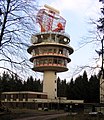Radar tower

A radar tower is a tower whose function is to support a radar facility, usually a local airport surveillance radar, and hence often at or in the vicinity of an airport or a military air base. The antenna is often continually rotating.[1] In addition, radar towers are used for the installation and operation of search and height finder radars at military radar stations, where the mission is to support air defense missions. These missions were characterized as Aircraft Control & Warning (AC&W), or Long Range Surveillance in support of the Semi-Automatic Ground Environment (SAGE).[2]
The tower typically has a continuously rotating parabolic antenna. Often, the antenna is protected from the weather by a radome, and is thus not visible from the outside.[citation needed]
For regional air traffic control, en route radar installations are used.[1] The data from these radars is fed into the civilian RADNET system and transferred to all civil and military control centres.
Ideally, a radar tower is built on a high spot in the terrain, because this reduces the angle of elevation, and thus increases the range of the radar device.[citation needed] In the absence of a suitable high spot, radar towers are used. Radar towers are also need to provide weather protection and services (air conditioning and power) for the radar equipment, communications, operators and maintainers.[citation needed]
In Germany, the operational command posts of the German Air Force use the Bundeswehr radar towers for the stationary radar sites of the operational command areas.[citation needed] In Britain, radar gave them the edge during the Battle of Britain, allowing Britain to detect incoming air raids before they arrived.[3]
Military radar stations have supported US and allied air defense operations at numerous worldwide locations since World War II.[4] The largest network of military radar stations evolved during the Cold War era to support the air defense of North America as part of the joint US and Canadian command known as the North American Air Defense Command (NORAD). This military radar network became automated in 1960 with the operation of SAGE.[citation needed] SAGE provided the vital command, control, communications, and computers (C4S).
Long Range Radar (LRR) stations were electronically connected to SAGE Direction Centers (DCs).[citation needed] This resulted in an integrated air defense system made up of radar, radio, interceptor aircraft, antiaircraft guns and missiles, and command and control (C2) facilities. Most of the radar and radio facilities were not on a military air base, but smaller Air Force Stations (AFS), are usually located in rural, and sometimes isolated locations that are often miles away from even small towns. They were staffed by up to several hundred Air Force personnel.[citation needed]
This includes the AN/FPS-24 search radar tower that sits in a huge 64 foot square, 85 foot tall, six-story building. On top of this radar tower was a radar antenna 50 feet tall, 120 feet wide, weighing 85.5 tons, and rotating at 5 rpm. An available rigid radome 140 feet in diameter and 96 feet high protected this antenna from adverse weather conditions.[citation needed]
-
Tower with en route radar at Neunkircher Höhe in the Odenwald
-
Radar tower for monitoring shipping on the South Elbe river opposite the Altenwerder Container Terminal, Hamburg
-
The Former Weesow radar tower in Werneuchen
-
Radar station on a mountain in France
References
[edit]- ^ a b "Airport Surveillance Radar (ASR-11)".
- ^ "SAGE: Semi-Automatic Ground Environment Air Defense System | MIT Lincoln Laboratory". www.ll.mit.edu. Retrieved 2024-01-19.
- ^ "How Radar Gave Britain The Edge In The Battle Of Britain". Imperial War Museums. Retrieved 2024-01-19.
- ^ "Western Air Defense Sector | Washington State Military Department, Citizens Serving Citizens with Pride & Tradition". mil.wa.gov. Retrieved 2024-01-19.




